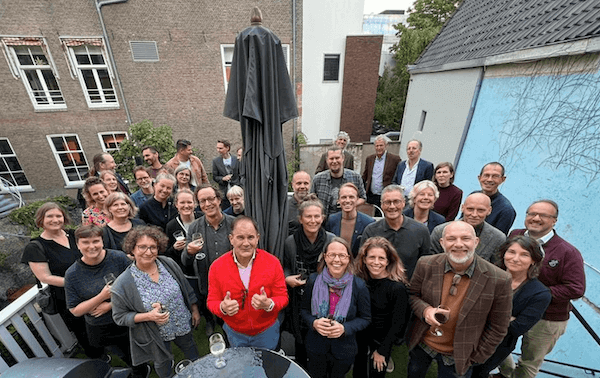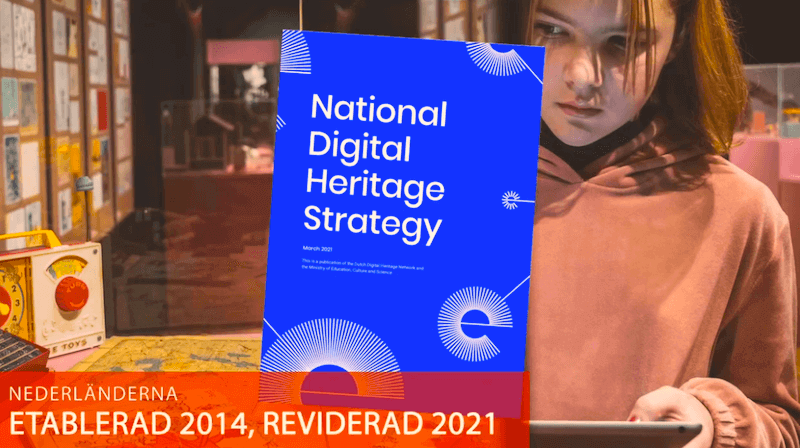
Zweden maakt werk van een toekomstgerichte Nationale Strategie Digitaal Erfgoed
In navolging van Nederland werkt de Swedish National Heritage Board aan een Nationale Strategie Digitaal Erfgoed. In 2022 bezocht een groep collega’s van de Heritage Board Nederland om de Nationale Strategie in de praktijk te zien. Op uitnodiging reisde Enno Meijers, Chief Technology Officer bij het Netwerk Digitaal Erfgoed, onlangs naar Zweden om kennis uit te wisselen. Welke stappen hebben onze Zweedse collega’s inmiddels gezet?
Scroll down for the English translation of this article
Domeinoverstijgende Nationale Strategie
Enno Meijers: ‘De Swedish National Heritage Board heeft grote vooruitgang geboekt richting een Nationale Strategie Digitaal Erfgoed, mede dankzij hun bezoek aan Nederland vorig jaar. Onze aanpak en ideeën hebben hen geïnspireerd om serieus aan de slag te gaan. Ze voerden de afgelopen tijd gesprekken met allerlei partners in hun netwerk, en vooral de museumsector toont veel enthousiasme.’
‘Aangezien het werkgebied van de Swedish National Heritage Board gericht is op de museumsector, is het voor bibliotheken en archieven niet direct vanzelfsprekend om aan te haken bij dit initiatief. Maar de Swedish National Heritage Board streeft echt naar een brede, domeinoverstijgende Nationale Strategie, net zoals wij die in Nederland kennen. Ze denken hierbij vanuit de gebruiker, en niet vanuit de afzonderlijke sectoren.’
Linked data verbindt collecties
‘Net als wij zetten ze in op het gebruik van linked data om digitale collecties van verschillende organisaties beter met elkaar te verbinden en zo diensten te ontwikkelen waarin informatie uit collecties wordt samengebracht. De eerste stap is om het Swedish Open Cultural Heritage-platform, dat onder andere de verbinding met Europeana verzorgt, volledig om te zetten naar linked data.’
‘Om de informatie op dit platform beter te verbinden, willen ze graag meer verwijzingen naar terminologiebronnen in de collectiebeschrijvingen opnemen. Ook hebben ze veel belangstelling voor onze oplossing om terminologiebronnen samen te brengen in het Termennetwerk. We hebben uitgebreid gesproken over hoe ze een Zweedse versie van het Termennetwerk kunnen opzetten.’
Internationale belangstelling voor Termennetwerk
‘Dit laatste is een gunstige ontwikkeling, juist voor Nederland. Wanneer steeds meer organisaties de open source software van het Termennetwerk omarmen, neemt de kans toe dat deze software op de lange termijn beschikbaar blijft. Want voor levensvatbare open source projecten is het belangrijk dat er meer partijen zijn die met de software werken en bijdragen aan de verdere ontwikkeling ervan. Overigens hebben niet alleen Zweedse, maar ook Belgische en Duitse collega’s interesse getoond in het Termennetwerk.’
DERA in de praktijk
‘In Zweden wordt ook nagedacht over een Datasetregister, vergelijkbaar met het onze. Bovendien hebben we uitvoerig gesproken over de rol van de Digitaal Erfgoed Referentie Architectuur (DERA) binnen ons netwerk en met name de voordelen die zij ons biedt. Het opstellen van een referentie-architectuur vergt aanzienlijke inspanningen en kan op verschillende manieren gebeuren. De collega’s wilden graag horen wat onze ervaringen zijn.’
‘De aanpak om de DERA verder te brengen via maandelijkse sessies van de Architectuurraad, en tegelijkertijd praktisch samen te werken met softwareleveranciers en erfgoedorganisaties om zaken uit te proberen en daarvan te leren in het kader van het NDE-werkprogramma, sprak hen bijzonder aan.’
Reflectie op eigen werk
‘Het bezoek aan de Zweedse collega’s en de discussies over deze onderwerpen waren uitermate boeiend. Dit opent perspectieven voor toekomstige samenwerking met netwerken die aan vergelijkbare doelen werken, waardoor we kunnen profiteren van elkaars kennis en oplossingen. Tegelijkertijd bieden de gesprekken mij de gelegenheid nog eens goed na te denken over wat wij de afgelopen tijd in het Netwerk Digitaal Erfgoed hebben gedaan en welke keuzes we daarbij hebben gemaakt. Een mooie aanleiding om op ons eigen werk te reflecteren.’
Sweden is actively pursuing a forward-looking National Digital Heritage Strategy
Following the example of the Netherlands, the Swedish National Heritage Board is developing its own National Digital Heritage Strategy. In 2022, a group of colleagues from the Heritage Board visited the Netherlands to observe the National Strategy in practice. Enno Meijers, Chief Technology Officer at the Network Digital Heritage, was recently invited to Sweden to exchange knowledge. What steps have our Swedish colleagues taken in the meantime?
Cross-domain National Strategy
Enno Meijers: ‘The Swedish National Heritage Board has made significant progress toward a National Digital Heritage Strategy, thanks in part to their visit to the Netherlands last year. Our approach and ideas inspired them to get seriously involved. They have been engaging with various partners in their network, and the museum sector, in particular, is showing a lot of enthusiasm.’
‘Since the focus of the Swedish National Heritage Board is primarily on the museum sector, it may not be immediately evident for libraries and archives to be part of this initiative. However, the Swedish National Heritage Board genuinely aims for a broad, cross-domain National Strategy, similar to what we have in the Netherlands. They are approaching this from a user-centric perspective rather than focusing on individual sectors.’
Linked data connecting collections
‘Just like us, they are emphasizing the use of linked data to better connect digital collections from different organizations and develop services that bring together information from these collections. Their first step is to fully transition the Swedish Open Cultural Heritage platform, which includes connections to Europeana, into linked data.’
‘To enhance the connection of information on this platform, they intend to include more references to terminology sources in collection descriptions. They also expressed great interest in our solution for aggregating terminology sources in the Network of Terms. We discussed in detail how they can establish a Swedish version of the Network of Terms.”
International Interest in the Network of Terms
‘This is a positive development, especially for the Netherlands. As more organizations embrace the open-source software of the Network of Terms, the likelihood that this software remains available in the long term increases. Because viable open-source projects require multiple parties working with the software and contributing to its further development. Not only Swedish but also Belgian and German colleagues have shown interest in the Network of Terms.’
DERA in practice
‘In Sweden, they are also considering a Dataset Register, similar to ours. Furthermore, we extensively discussed the role of the Digital Heritage Reference Architecture (DERA) within our network, especially the benefits it offers us. Developing a reference architecture requires significant efforts and can be done in various ways. Our colleagues were interested in hearing about our experiences.’
‘The approach of advancing DERA through monthly sessions of the Architecture Council while simultaneously collaborating practically with software vendors and heritage organizations to experiment and learn within the framework of the NDE work program resonated with them.’
Reflection on our work
‘My visit to our Swedish colleagues and the discussions on these topics were highly engaging. This opens up prospects for future collaborations with networks working towards similar goals, allowing us to benefit from each other’s knowledge and solutions. At the same time, these conversations provide me with an opportunity to reflect on what we have accomplished in the Network Digital Heritage in recent times and the choices we have made. A great occasion for introspection on our own work.’
Op de hoogte blijven?
Gerelateerd nieuws

